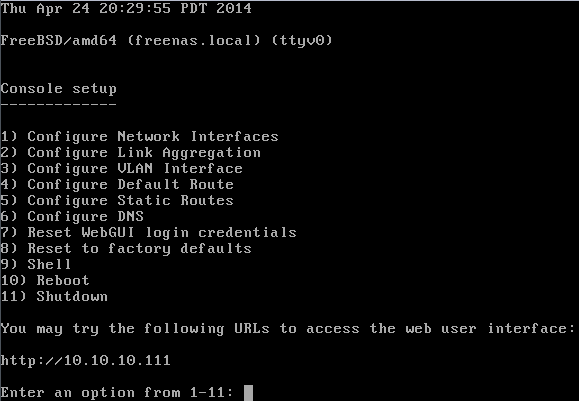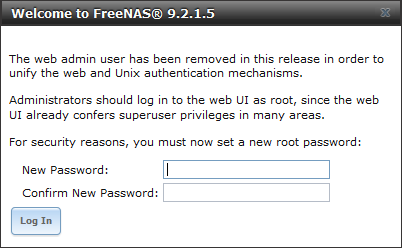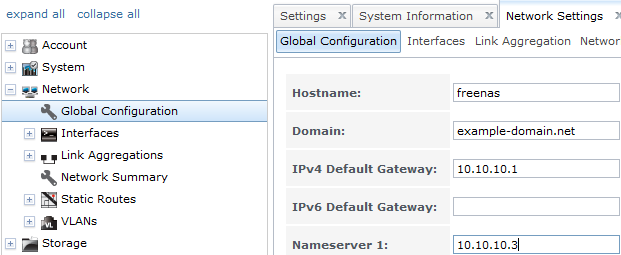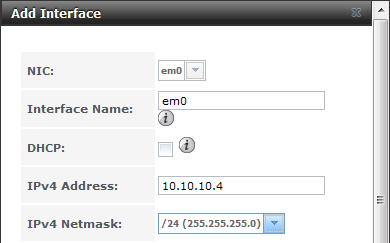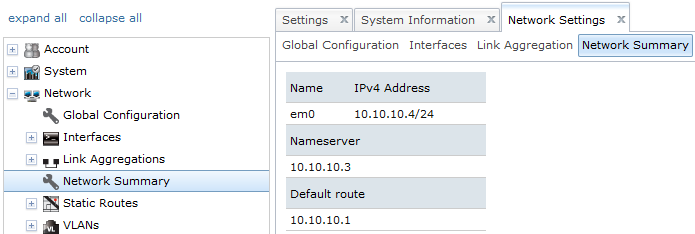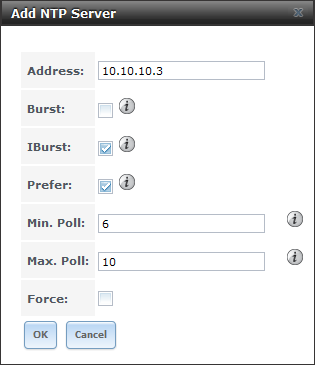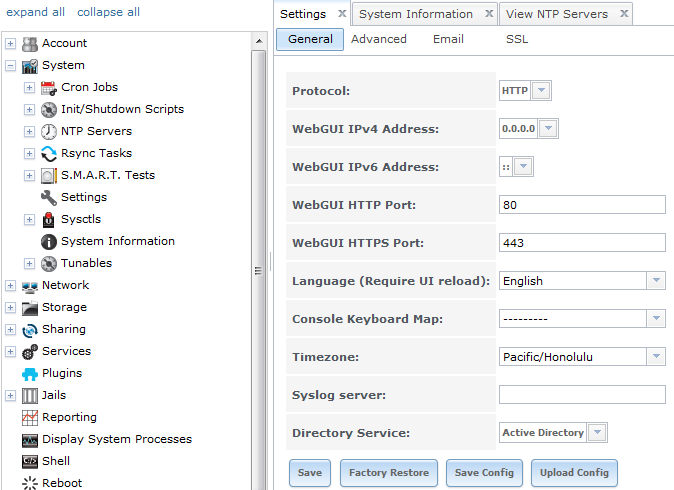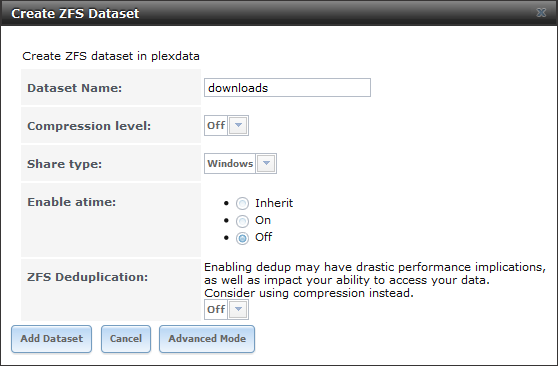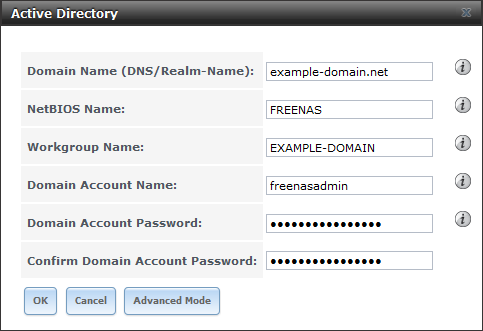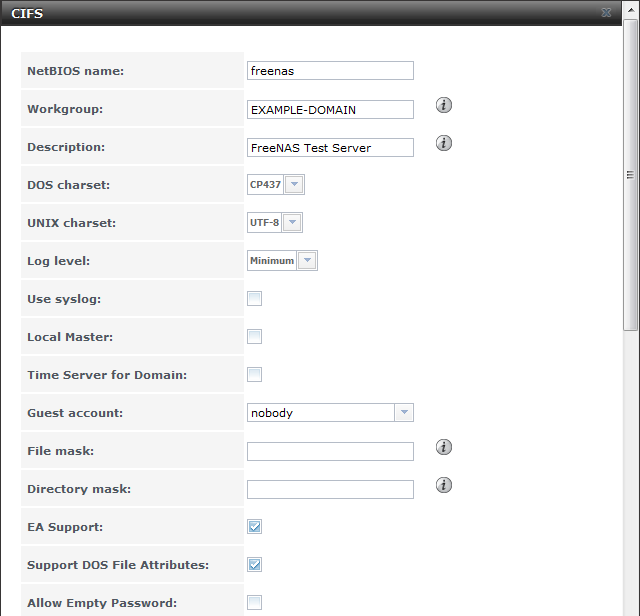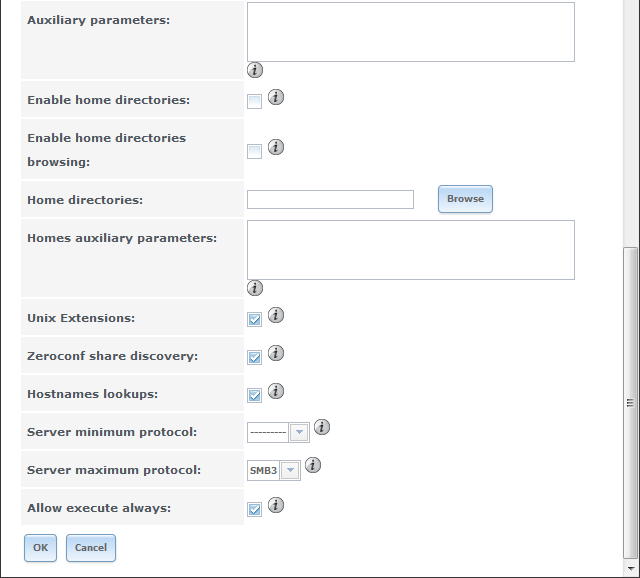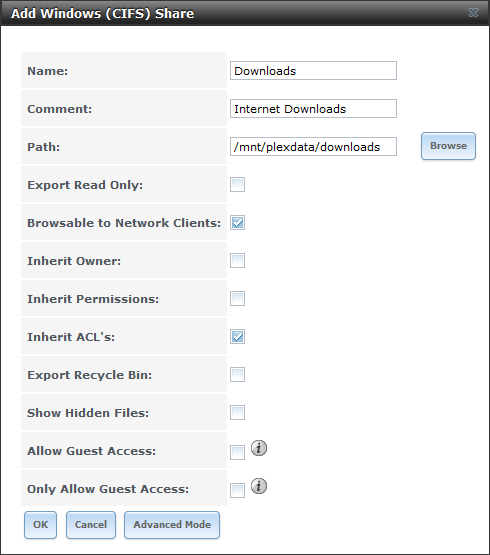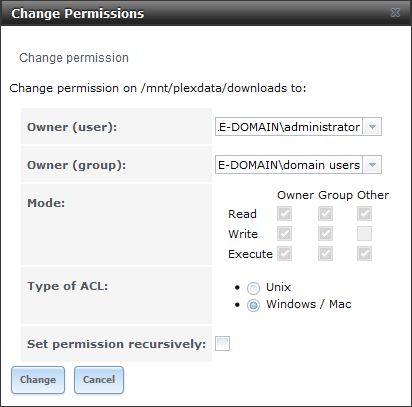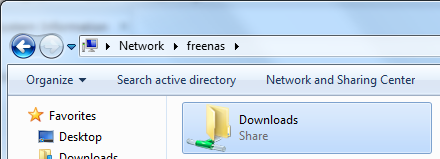FreeNAS 9.2.1.5 setup
From FreeNAS using Active Directory Wiki
Contents
Before we start
- We used a virtualized setup in order to create this walkthrough, using generic domain & computer names where possible.
- We used the private IP address range of 10.10.10.x - obviously you'll want to replace our internal IP addresses with your own
- We used a single Active Directory domain controller, to keep things simple. We then configured the following network settings, which is reflected throughout this document:
- Gateway: 10.10.10.1
- DNS: 10.10.10.3
- NTP: 10.10.10.3
- DC (Domain Controller): 10.10.10.3
- FreeNAS: 10.10.10.4
- We used a single Active Directory domain controller, to keep things simple. We then configured the following network settings, which is reflected throughout this document:
- Where appropriate, we'll make a note of where additional server IP's can be entered, for redundancy
Getting started with FreeNAS
Initial connection
- When FreeNAS 9.2.1.5 is first installed, the network adapter is set to DHCP - we will change this a few steps down. We will be configuring FreeNAS purely from the webUI, so make a note of the IP on the FreeNAS server console:
- Use your favorite web browser to connect to that address - the first visit to the FreeNAS webUI will prompt you for a password, for the default user root
Configuring networking
- Click on Network -> Global Configuration
- Hostname: freenas (this needs to match the DNS "A" record & computer account name you created during the Active Directory prep)
- Domain: example-domain.net
- IPv4 Default Gateway: 10.10.10.1
- Nameserver 1: 10.10.10.3
- Click "Save"
- Click on Network -> Interfaces -> Add Interface
- NIC: select the NIC being used by FreeNAS (single NIC systems only have 1 item in the dropdown list)
- Interface Name: em0 (We named it the same as what FreeNAS names it, for consistency - you can name it whatever you like)
- DHCP: unchecked
- IPv4 Address: 10.10.10.4 (this needs to match the DNS "A" record you created during the Active Directory prep)
- IPv4 Netmask: /24
- Click "Save"
- The new IP address takes effect immediately - repoint your browser to the new address to continue
- Click on Network -> Network Summary to verify previous settings
Configuring Time Server
- Click on System -> NTP Servers -> View NTP Servers
- Remove all 3 default NTP servers
- Click Add NTP Server
- Address: 10.10.10.3
- Prefer: checked (only if you have other time servers configured)
- Leave everything else at its default setting
- Now that the time server is set, you need to set your time zone
- Click on Settings -> General
- Timezone: (obviously select YOUR time zone)
- Directory Service: Active Directory (since we plan on using Active Directory)
- Click "Save"
Creating a Storage Pool
- Your storage pool has to be created before you configure FreeNAS to use Active Directory, however that is beyond the scope of this how-to.
- The official FreeNAS wiki is an excellent resource on creating your storage pool.
- We also suggest giving cyberjocks excellent PowerPoint presentation explaining what VDev zpool, ZIL and L2ARC is.
- After your pool is created, we suggest creating a dataset specifically for CIFS sharing.
- Again, the official FreeNAS wiki is a good source of info on how to do this
- When creating the dataset, you have to take into consideration how this particular dataset will be used.
- In this how-to, we are assuming the storage will be used to store already compressed files, and the following screenshot reflects that.
- Dataset Name: downloads
- Compression level: Off (everything's already compressed already)
- Share type: Windows
- Enable atime: Off (unless your backup solution scans this share, then turn it on)
- ZFS Deduplication: Off
Setting up Active Directory & CIFS
- Click on Services -> Directory Services -> Active Directory
- Domain name: example-domain.net
- NetBIOS Name: FREENAS
- Workgroup Name: EXAMPLE-DOMAIN
- Domain Account Name: freenasadmin
- Domain Account Password: StrongPassword1234
- Confirm Domain Account Password: StrongPassword1234
- Click on Services -> CIFS
- NetBIOS name: freenas
- Workgroup: EXAMPLE-DOMAIN
- Description: (optional to fill in)
- DOS charset: CP437
- UNIX charset: UTF-8
- Log Level: Minimum
- Use syslog: unchecked
- Local Master: unchecked
- Time Server for Domain: unchecked
- Guest Account: nobody
- File Mask: (leave this field blank)
- Directory Mask: (leave this field blank)
- EA Support: checked
- Support DOS File Attributes: checked
- Allow Empty Password: unchecked
- Auxiliary Parameters: (leave this field blank)
- Enable home directories: unchecked
- Enable home directories browsing: unchecked
- Home directories: (leave this field blank)
- Homes auxiliary parameters: (leave this field blank)
- Unix Extensions: checked
- Zeroconf share discovery: checked
- Hostnames lookups: checked
- Server minimum protocol: ---------
- Server maximum Protocol: SMB3
- Allow execute always: checked
- Click "OK"
- Click Services -> Control Services
- Turn on Directory Services
- This will also automatically turn on the CIFS services. Turning on Directory Services can take up to a minute to start, be patient.
- Turn on Directory Services
- Click on Sharing -> Windows (CIFS) Shares -> Add Windows (CIFS) Share
- Name: Downloads (this is the name you'll see when you connect via Windows Explorer)
- Comment: (optional)
- Path: (browse to the path of the dataset created previously)
- Leave everything else at its default setting
- Click "OK"
Dataset File/Folder Permissions
- Now we need to change the default owner & group on the dataset created
- Click on Store -> Volumes
- Expand your volumes until you find the dataset created for file sharing
- Click Change Permissions
- Owner (user): EXAMPLE-DOMAIN\administrator
- Owner (group): EXAMPLE-DOMAIN\domain users
- Mode: (unchangeable)
- Type of ACL: Windows / Mac
- Set permission recursively: unchecked (unless you have files owned by a FreeNAS user stored in this dataset already)
- Click "Change"
Verification
- From a Windows client, open Windows Explorer, and type in \\freenas - if everything is set properly, you should see the CIFS share you created earlier.
- Enter into the shared directory, and as a simple test - create a folder. If you're allowed, then it worked!
- If you go into the FreeNAS shell, you can further verify permissions are using Active Directory style permissions
